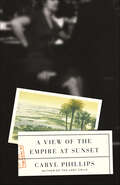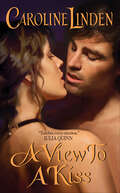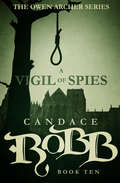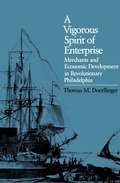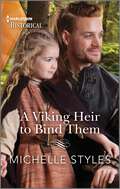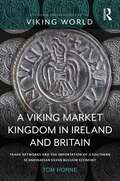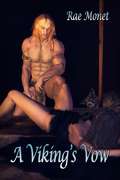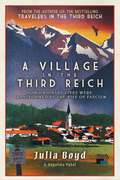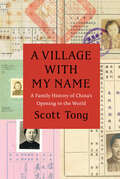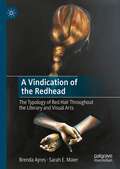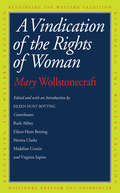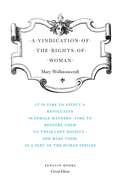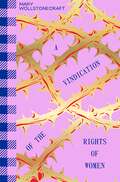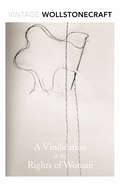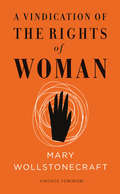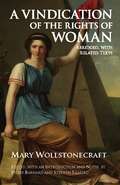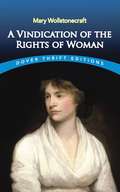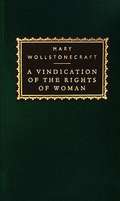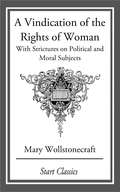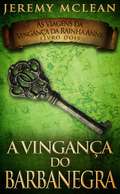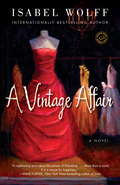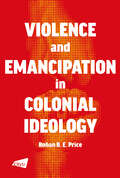- Table View
- List View
A View of the Empire at Sunset: A Novel
by Caryl PhillipsAward-winning author Caryl Phillips presents a biographical novel of the life of Jean Rhys, the author of Wide Sargasso Sea, which she wrote as a prequel to Charlotte Brontë’s Jane Eyre. Caryl Phillips’s A View of the Empire at Sunset is the sweeping story of the life of the woman who became known to the world as Jean Rhys. Born Ella Gwendolyn Rees Williams in Dominica at the height of the British Empire, Rhys lived in the Caribbean for only sixteen years before going to England. A View of the Empire at Sunset is a look into her tempestuous and unsatisfactory life in Edwardian England, 1920s Paris, and then again in London. Her dream had always been to one day return home to Dominica. In 1936, a forty-five-year-old Rhys was finally able to make the journey back to the Caribbean. Six weeks later, she boarded a ship for England, filled with hostility for her home, never to return. Phillips’s gripping new novel is equally a story about the beginning of the end of a system that had sustained Britain for two centuries but that wreaked havoc on the lives of all who lived in the shadow of the empire: both men and women, colonizer and colonized.A true literary feat, A View of the Empire at Sunset uncovers the mysteries of the past to illuminate the predicaments of the present, getting at the heart of alienation, exile, and family by offering a look into the life of one of the greatest storytellers of the twentieth century and retelling a profound story that is singularly its own.
A View of the State of Ireland
by Andrew Hadfield Willy Maley Edmund SpenserA translation which maintains much of the spelling of the time.
A View to a Death in the Morning: Hunting and Nature Through History
by Matt CartmillWhat brought the ape out of the trees, and so the man out of the ape, was a taste for blood. This is how the story went, when a few fossils found in Africa in the 1920s seemed to point to hunting as the first human activity among our simian forebears—the force behind our upright posture, skill with tools, domestic arrangements, and warlike ways. Why, on such slim evidence, did the theory take hold? In this engrossing book Matt Cartmill searches out the origins, and the strange allure, of the myth of Man the Hunter. An exhilarating foray into cultural history, A View to a Death in the Morning shows us how hunting has figured in the western imagination from the myth of Artemis to the tale of Bambi—and how its evolving image has reflected our own view of ourselves. A leading biological anthropologist, Cartmill brings remarkable wit and wisdom to his story. Beginning with the killer-ape theory in its post–World War II version, he takes us back through literature and history to other versions of the hunting hypothesis. Earlier accounts of Man the Hunter, drafted in the Renaissance, reveal a growing uneasiness with humanity’s supposed dominion over nature. By delving further into the history of hunting, from its promotion as a maker of men and builder of character to its image as an aristocratic pastime, charged with ritual and eroticism, Cartmill shows us how the hunter has always stood between the human domain and the wild, his status changing with cultural conceptions of that boundary. Cartmill’s inquiry leads us through classical antiquity and Christian tradition, medieval history, Renaissance thought, and the Romantic movement to the most recent controversies over wilderness management and animal rights. Modern ideas about human dominion find their expression in everything from scientific theories and philosophical assertions to Disney movies and sporting magazines. Cartmill’s survey of these sources offers fascinating insight into the significance of hunting as a mythic metaphor in recent times, particularly after the savagery of the world wars reawakened grievous doubts about man’s place in nature. A masterpiece of humanistic science, A View to a Death in the Morning is also a thoughtful meditation on what it means to be human, to stand uncertainly between the wilderness of beast and prey and the peaceable kingdom. This richly illustrated book will captivate readers on every side of the dilemma, from the most avid hunters to their most vehement opponents to those who simply wonder about the import of hunting in human nature.
A View to a Kiss
by Caroline LindenAn English spy is distracted by a noble beauty while hunting for a traitor in this sensual Regency romance series opener by a USA Today–bestselling author.Mystifying kisses . . . It was a most coveted invitation—a glittering ball attended by all the important people of the ton. But Mariah, a ravishing beauty thought by all to be the catch of the season, never expected to find true love amid the shadows. The mysterious man she meets there ignites a passion within her she never thought possible. When he starts a clandestine midnight courtship in her bedroom, Mariah is scandalized—and enthralled.From a man who knows just what he desires . . . Harry Sinclair is a man of secrets who would do anything to protect those in his charge. But when he lays eyes on the stunning Mariah, duty and desire collide. Though every man in London lusts for her, he knows the fiery attraction between them is unparalleled. But in a world where trust can turn to treason and scandal can topple the throne, Harry and Mariah will fight a perilous fight for their precious love—and their lives.
A Vigil of Spies: The Owen Archer Series - Book Ten (The Owen Archer Series #10)
by Candace Robb“As always, Candace Robb writes a powerful story intertwined with genuine characters of the day.” —HISTORICAL NOVEL REVIEW Archbishop Thoresby of York, the second most powerful cleric in England, lies dying in his bed. The end of his life is seen by the great families of the North as a chance to promote one of their own as his successor, and Thoresby himself announces he will leave the matter to the dean and chapter of York. On the eve of this decision, the dying archbishop agrees to a visit from Joan, Princess of Wales, wife of the Black Prince, heir to the throne of England. Thoresby’s captain of the guard, Owen Archer, has no doubt that trouble will follow. As soon as the company rides into the palace yard he is proved right: they arrive burdened with the body of one of their party, and Owen finds evidence that the man’s death was no accident. Within days of this discovery, a courier carrying an urgent message for the archbishop is found hanging in the woods. With guards surrounding the property, it is clear that the murderer walks among the palace guests. The powerful Percy and Neville families are well represented in the entourage, including a woman who remembers an afternoon tryst with Owen as much, much more. Even the princess’ son is suspect. As Owen races to unmask the guilty and rid the palace of the royal party, his final wish for his lord is that he might die in peace.
A Vigilant Society: Jewish Thought and the State in Medieval Spain
by Javier RoizA Vigilant Society presents a provocative hypothesis that argues that Western society as we know it emerged from the soil of Jewish intellectual advances in the thirteenth century, especially those formulated on the Iberian Peninsula. A paradigmatic shift began to occur, one that abandoned the pre–Gothic Sephardic wisdom found in, for example, the writings of Maimonides in favor of what author Javier Roiz calls the "vigilant society." This model embraces a conception of politics that includes a radical privatization of an individual's interior life and—especially as adopted and adapted in later centuries by Roman Catholic and Calvinist thinkers—is marked by a style of politics that accepts the dominance of power and control as given. Vigilant society laid the foundation for the Western understanding of politics and its institutions and remains pervasive in today's world.
A Vigorous Spirit of Enterprise
by Thomas M. DoerflingerA social, economic, and political study of Philadelphia merchants, this study presents both the spirit and statistics of merchant life. Doerflinger studies the Philadelphia merchant community from three perspectives: their commercial world, their confrontation with the Revolution and its aftermath, and their role in diversifying the local economy. The analysis of entrepreneurship dominates the study and challenges long-standing assumptions about American economic history.
A Viking Heir to Bind Them
by Michelle StylesThis Viking is about to uncover an explosive secret!An unexpected family For the lone-wolf warrior Nothing daunts Viking Tylir, until unassuming Melkorka Helmsdottar upends his life by revealing he has a secret heir! Mel has looked after little Katla since the girl&’s mother died, but now Tylir intends to claim his child. Yet this battle-hardened jarl has no idea how to be a father. Mel is the perfect person to help him. Only, spending time with the captivating Mel binds him closer to her than he ever thought possible… From Harlequin Historical: Your romantic escape to the past.
A Viking Market Kingdom in Ireland and Britain: Trade Networks and the Importation of a Southern Scandinavian Silver Bullion Economy (Routledge Archaeologies of the Viking World)
by Tom HorneViking-Age trade, network theory, silver economies, kingdom formation, and the Scandinavian raiding and settlement of Ireland and Britain are all popular subjects. However, few have looked for possible connections between these phenomena, something this book suggests were closely related. By allying Blomkvist’s network-kingdoms with Sindbæk’s nodal market-networks, it is argued that the political and economic character of Viking-Age Britain and Ireland – my ‘Insular Scandinavia’ – is best understood if Dublin and Jórvík are seen as being established as nodes of a market-based network-kingdom. Based on a dataset relating to the then developing bullion economies of the central and eastern Scandinavian worlds and southern Scandinavia in particular, it is argued that war-band leaders from, or familiar with, ‘Danish’ markets like Hedeby and Kaupang transposed to Insular Scandinavia the concept of polities based on establishment of markets and the protection of routeways between them. Using this book, readers can think of interlinked Dublin and Great Army elites creating an Insular version of a Danish-style nodal market kingdom based on commerce and silver currencies. A Viking Market Kingdom in Ireland and Britain will help specialist researchers and students of Viking archaeology make connections between southern Scandinavia and the market economy of the Uí Ímair (‘descendants of Ívarr’) operating out of the twin nodes of Dublin and Jórvík via the initial establishment of Hiberno-Scandinavian longphuirt and the related winter-camps of the Viking Great Army.
A Viking's Vow
by Rae MonetA female Wolf Warrior honor bound to protect the Solarian wolves, and their secrets. A fierce Viking, determined to save his people. More than weapons clash as they meet in the highland forests of Scotland in Rae Monet's hot, historical romance A Vikings Vow.The year is 1311.The day of the Viking is coming to an end.They called him Eirik the Fierce. A Norseman bred from a long line of Viking Jarls and the leader of a starving Icelandic settlement. The news from England--the King is offering a bounty equal to a year's harvest for the pelts of Scotland's wolves.What Eirik found in the highland forests of Scotland was much more valuable than he could imagine. Her name was Sable.For Sable, protecting the lives of the Solarian wolves is ingrained into the soul of every Wolf Warrior. When the battle-trained Norsemen invade the Realm territory, Sable has no choice but to fight. Forced into submission and taken prisoner Sable must surrender or die.However, Eirik will find a female Wolf Warrior of the highest order does not take well to a life of Viking slave and he begins to wonder which of them has become enslaved.
A Village in the Third Reich: How Ordinary Lives Were Transformed by the Rise of Fascism
by Julia Boyd Angelika PatelAn intimate portrait of German life during World War II, shining a light on ordinary people living in a picturesque Bavarian village under Nazi rule, from a past winner of the Los Angeles Times Book Prize for History.Hidden deep in the Bavarian mountains lies the picturesque village of Oberstdorf—a place where for hundreds of years people lived simple lives while history was made elsewhere. Yet even this remote idyll could not escape the brutal iron grip of the Nazi regime. From the author of the international bestseller Travelers in the Third Reich comes A Village in the Third Reich, shining a light on the lives of ordinary people. Drawing on personal archives, letters, interviews and memoirs, it lays bare their brutality and love; courage and weakness; action, apathy and grief; hope, pain, joy, and despair. Within its pages we encounter people from all walks of life – foresters, priests, farmers and nuns; innkeepers, Nazi officials, veterans and party members; village councillors, mountaineers, socialists, slave labourers, schoolchildren, tourists and aristocrats. We meet the Jews who survived – and those who didn&’t; the Nazi mayor who tried to shield those persecuted by the regime; and a blind boy whose life was judged "not worth living." This is a tale of conflicting loyalties and desires, of shattered dreams—but one in which, ultimately, human resilience triumphs. These are the stories of ordinary lives at the crossroads of history.
A Village with My Name: A Family History of China's Opening to the World
by Scott TongWhen journalist Scott Tong moved to Shanghai, his assignment was to start up the first full-time China bureau for “Marketplace,” the daily business and economics program on public radio stations across the United States. But for Tong the move became much more—it offered the opportunity to reconnect with members of his extended family who had remained in China after his parents fled the communists six decades prior. By uncovering the stories of his family’s history, Tong discovered a new way to understand the defining moments of modern China and its long, interrupted quest to go global. A Village with My Name offers a unique perspective on the transitions in China through the eyes of regular people who have witnessed such epochal events as the toppling of the Qing monarchy, Japan’s occupation during World War II, exile of political prisoners to forced labor camps, mass death and famine during the Great Leap Forward, market reforms under Deng Xiaoping, and the dawn of the One Child Policy. Tong’s story focuses on five members of his family, who each offer a specific window on a changing country: a rare American-educated girl born in the closing days of the Qing Dynasty, a pioneer exchange student, an abandoned toddler from World War II who later rides the wave of China’s global export boom, a young professional climbing the ladder at a multinational company, and an orphan (the author’s daughter) adopted in the middle of a baby-selling scandal fueled by foreign money. Through their stories, Tong shows us China anew, visiting former prison labor camps on the Tibetan plateau and rural outposts along the Yangtze, exploring the Shanghai of the 1930s, and touring factories across the mainland. With curiosity and sensitivity, Tong explores the moments that have shaped China and its people, offering a compelling and deeply personal take on how China became what it is today.
A Vindication of the Redhead: The Typology of Red Hair Throughout the Literary and Visual Arts
by Brenda Ayres Sarah E. MaierA Vindication of the Redhead investigates red hair in literature, art, television, and film throughout Eastern and Western cultures. This study examines red hair as a signifier, perpetuated through stereotypes, myths, legends, and literary and visual representations. Brenda Ayres and Sarah E. Maier provide a history of attitudes held by hegemonic populations toward red-haired individuals, groups, and genders from antiquity to the present. Ayres and Maier explore such diverse topics as Judeo-Christian narratives of red hair, redheads in Pre-Raphaelite paintings, red hair and gender identity, famous literary redheads such as Anne of Green Gables and Pippi Longstocking, contemporary and Neo-Victorian representations of redheads from the Black Widow to The Girl with the Dragon Tattoo, and more. This book illuminates the symbolic significance and related ideologies of red hair constructed in mythic, religious, literary, and visual cultural discourse.
A Vindication of the Rights of Woman
by Mary Wollstonecraft Eileen Hunt BottingMary Wollstonecraft's visionary treatise, originally published in 1792, was the first book to present women's rights as an issue of universal human rights. Ideal for coursework and classroom study, this comprehensive edition of Wollstonecraft's heartfelt feminist argument includes illuminating essays by leading scholars that highlight the author's significant contributions to modern political philosophy, making a powerful case for her as one of the most substantive political thinkers of the Enlightenment era. No other scholarly work to date has examined as closely both the ideological moorings and the enduring legacy of Wollstonecraft's groundbreaking and courageous discourse.
A Vindication of the Rights of Woman
by Mary WollstonecraftFirst published in 1792, A Vindication of the Rights of Woman was an instant success, turning its thirty-three-year-old author into a minor celebrity. A pioneering work of early feminism that extends to women the Enlightenment principle of "the rights of man," its argument remains as relevant today as it was for Woll-stonecraft's contemporaries. "Mary Wollstonecraft was not the first writer to call for women to receive a real, challenging education," writes Katha Pollitt in the new Introduction. "But she was the first to connect the education of women to the transformation of women's social position, of relations between the sexes, and even of society itself. She was the first to argue that women's intellectual equality would and should have actual consequences. The winds of change sweep through her pages." This classic work of early feminism remains as relevant and passionate today as it was for Wollstonecraft's contemporaries. This edition includes new explanatory notes.From the Trade Paperback edition.
A Vindication of the Rights of Woman (Cambridge Texts In The History Of Political Thought Ser.)
by Mary WollstonecraftA seminal book in a feminist conversation that still continues today.Now regarded as one of the founding feminist philosophers, Mary Wollstonecraft's writings have inspired conversation and action since their first publication. Wollstonecraft produced this declaration of female independence in 1792. Passionate, eloquent and forthright, it launched a scathing attack on the current understanding of women and laid out the tenets for a new vision: equal education, an end to prejudice and a chance for women to become defined by their profession, not their partner. Whereas Mary Wollstonecraft's work was received at the time with a mixture of admiration and outrage, she is now rightly viewed as a powerful matriarch of modern feminism.Part of a boldly designed series of classics, with wider margins for notes, this book is perfect for design-lovers and students alike. With bold, eye-catching graphic covers by Evi O Studio, this collection aims to introduce a selection of the most celebrated works of the last thousand years to a new audience. Featuring tales of adventure, fiction from the 19th and 20th centuries, feminist writings, and reflections on art, politics, philosophy and the origins of man, this is a small, wide-reaching and essential collection.'My own sex, I hope, will excuse me, if I treat them like rational creatures.'
A Vindication of the Rights of Woman (Cambridge Texts In The History Of Political Thought Ser.)
by Mary WollstonecraftA key work of proto-feminism, Mary Wollstonecraft's readable and impassioned argument is as relevant today as it was two hundred years ago. Before the concept of equality between the sexes was even conceived, Wollstonecraft wrote this book, a treatise of proto-feminism that was as powerful and original then as it is now. In it she argues with clarity and originality for the rational education of women and for an increased female contribution to society. It was a cry for justice from a woman with no power other than her pen and it put in motion a drive towards greater equality between men and women, a movement which continues to this day. ‘The first great piece of feminist writing’ Independent
A Vindication of the Rights of Woman (Vintage Feminism Short Editions)
by Mary WollstonecraftDiscover Wollstonecraft’s classic feminist text in an abridged, digestible form.WITH AN INTRODUCTION BY ZOE WILLIAMS The term feminism did not yet exist when Mary Wollstonecraft wrote this book, but it was the first great piece of feminist writing. In these pages you will find the essence of her argument – for the education of women and for an increased female contribution to society. Her work made the first ripples of what would later become the tidal wave of the women’s rights movement. Rationalist but revolutionary, Wollstonecraft changed the world for women.Vintage Feminism: classic feminist texts in short form
A Vindication of the Rights of Woman: Abridged, with Related Texts
by Mary Wollstonecraft Stephen Shapiro Philip BarnardThis edition features a shrewd, annotated abridgment of Mary Wollstonecraft's A Vindication of the Rights of Woman (1792) accompanied by an array of texts that help situate the Vindication in its political, historical, and intellectual contexts. Included are key selections from Wollstonecraft's other writings; from closely related works by Burke, Paine, Godwin, Rousseau, Macaulay, Talleyrand, and Brockden Brown; and from the 1789 Declaration of the Rights of Man and Citizen and de Gouges' Declaration of the Rights of Woman and Female Citizen (1791).
A Vindication of the Rights of Woman: With Strictures On Political And Moral Subjects (Dover Thrift Editions)
by Mary WollstonecraftIn an era of revolutions demanding greater liberties for mankind, Mary Wollstonecraft (1759-1797) was an ardent feminist who spoke eloquently for countless women of her time.Having witnessed firsthand the devastating results of male improvidence, she assumed an independent role early in life, educating herself and eventually earning a living as a governess, teacher and writer. She was also an esteemed member of the radical intellectual circle that included William Godwin (father of her daughter, novelist Mary Godwin Shelley, and later her husband), Thomas Paine, William Blake, Henry Fuseli and others.First published in 1792, A Vindication of the Rights of Woman created a scandal in its day, largely, perhaps, because of the unconventional lifestyle of its creator. Today, it is considered the first great manifesto of women's rights, arguing passionately for the education of women: "Tyrants and sensualists are in the right when they endeavor to keep women in the dark, because the former want only slaves, and the later a plaything."No narrow-minded zealot, Wollstonecraft balanced passionate advocacy with a sympathetic warmth--a characteristic that helped her ideas achieve widespread influence. Anyone interested in the history of the women's rights movement will welcome this inexpensive edition of one of the landmark documents in the struggle for human dignity, freedom and equality.
A Vindication of the Rights of Woman: With Strictures on Political and Moral Subjects
by Mary Wollstonecraft Katha PolittArguably the earliest written work of feminist philosophy, Wollstonecraft produced a female manifesto in the time of the American and French Revolutions. This era induced many to reconsider not only the rights of men, but also of women, and none argued for female emancipation more eloquently or effectively than Wollstonecraft. Her strong use of analogy and philosophical language compared women of her day to both slaves and soldiers: forced to be docile and decorative. Wollstonecraft is passionate and candid as she lays out the principles feminine freedom, stating that education should be equal, there should be an end to the prejudices that proved so restrictive, and that women should be defined, not by their partner, but by their profession. Although received with both approval and anger, "A Vindication of the Rights of Woman" was ahead of its time, even modern, in its ideas, and it continues to be a foundational work for those who support women and equal rights.
A Vindication of the Rights of Woman: With Strictures on Political and Moral Subjects
by Mary WollstonecraftThis revolutionary work from the eighteenth century is one of the first tracts of feminist philosophy Mary Wollstonecraft wrote A Vindication of the Rights of Woman in opposition to the gender norms of the eighteenth century. In this seminal text, Wollstonecraft argues that women should receive a comprehensive education in order to benefit society. Women and men, she argues, are moral equals in the eyes of God, and women, at the time that Wollstonecraft was writing, occupied an inferior station because they were trained to serve only men rather than civilization as a whole. Written in response to Charles Maurice de Talleyrand-Périgord’s assertion that women ought only to receive a domestic education and should be confined to the home, A Vindication of the Rights of Woman was a remarkably forward-thinking political text.
A Vingança do Barba Negra
by Jeremy McLeanApós a tripulação do Barba Negra resgatá-lo da prisão, a busca pelas chaves de seu navio continua onde eles enfrentam provas mortais, e o sobrenatural, para completar sua propriedade marítima o tempo todo sendo perseguido por um assassino de origem desconhecida. Isso transforma os piedosos em pecadores, os mais tímidos a irados e os mais virtuosos em assassinos de sangue frio. Se usado corretamente, o desejo de vingança também pode ser usado como uma ferramenta. Edward Thatch, o pirata novato conhecido como Barba Negra, parte para a vingança. Vingança contra aqueles que enganaram seus colegas de tripulação e ele próprio. Antes que Edward possa receber sua retribuição, ele precisará terminar o desbloqueio de seu navio Liberdade, jogando o jogo de Benjamin Hornigold. Edward ainda tem três testes para completar, a fim de obter as últimas chaves de sua nave, e ele terá que arriscar a vida e a integridade de si mesmo e de sua equipe para passar nos testes. Até que ponto o desejo de Vingança de Edward o levará, e que perigos ele colocará sua tripulação para sua liberdade? Descubra qual ação Edward tomará em A Vingança do Barba Negra e siga sua aventura de fantasia cheia de piratas, corsários e tudo mais no meio de As Viagens da Vingança da Rainha Anne!
A Vintage Affair: A Novel
by Isabel WolffEvery dress has a history. And so does every woman. In Isabel Wolff's captivating A Vintage Affair, a treasured child's coat becomes a thread of hope connecting two very different women. Her friends are stunned when Phoebe Swift abruptly leaves a plum job at the prestigious Sotheby's auction house to open her own vintage clothing shop in London--but to Phoebe, it's the fulfillment of a dream. In the sunlight-flooded interior of Village Vintage, surrounded by Yves Saint Laurent silk scarves, Vivienne Westwood bustle skirts, cupcake dresses, and satin gowns, Phoebe hopes to make her store the hot new place to shop, even as she deals with two ardent suitors, her increasingly difficult mother, and a secret from her past that casts a shadow over her new venture.For Phoebe, each vintage garment carries its own precious history. Digging for finds in attics and wardrobes, Phoebe is rewarded whenever she finds something truly unique, for she knows that when you buy a piece of vintage clothing, you're not just buying fabric and thread--you're buying a piece of someone's past. But one particular article of clothing will soon unexpectedly change her life. Thérèse Bell, an elderly Frenchwoman, has an impressive clothing collection. But among the array of smart suits and couture gowns, Phoebe finds a child's sky-blue coat--an item with which Bell is stubbornly reluctant to part. As the two women become friends, Phoebe will learn the tale of that little blue coat. And she will discover an astonishing connection between herself and Thérèse Bell--one that will help her heal the pain of her own past and allow her to love again. From the Hardcover edition.
A Violence and Emancipation in Colonial Ideology
by Rohan PriceAre there ethics justifying anti-colonial violence? How and why did the violence and visions of nationalist movements become incorporated by colonial and neo-colonial rule? Using the insurrection by the Malayan Communist Party (1948–1960) as an example, this book argues that resorting to violence sped up the decolonisation of British Malaya by forcing its colonial administration to invent Malay nationalism and pursue ameliorative social policy among the Chinese diaspora community in a manner clearly derived from the Party's platform. Yet this was not the same as giving the country economic emancipation from the expectations of neo-colonial rule. Violence and Emancipation in Colonial Ideology entertains no warm colonial memories of the cold war years. Confirming Price's reputation as a plain speaking critic of Empire apologia, this book asks how colonial ideology was considered to be beneath Europe yet desperately needed by it. He faces down nostalgic communities defending an outdated view that "might was right" in South East Asia and that communism failed to contribute to the world that came to be. Using an Althusserian assumption, the book begs the question: if a late colonial state was subjective, then how did it claim a sufficiently objective mantle to rule and how did ideological techniques enable this?
